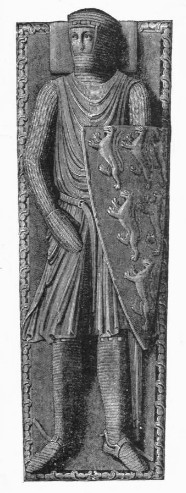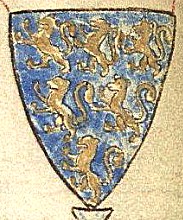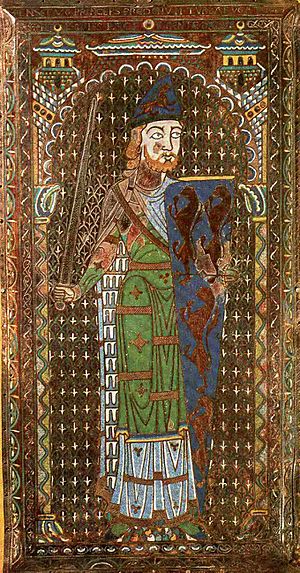William Longespée, 3rd Earl of Salisbury facts for kids
Quick facts for kids
William Longespée
|
|
|---|---|
| Earl of Salisbury | |

Drawing of effigy of William Longespée from his monument in Salisbury Cathedral
|
|
| Born | c. 1167 |
| Died | 7 March 1226 (aged 58–59) Salisbury Castle, Salisbury, Wiltshire, England |
| Noble family | Plantagenet |
| Spouse(s) | Ela, Countess of Salisbury |
| Issue among others... |
William II Longespée Nicholas Longespée |
| Father | Henry II of England |
| Mother | Ida de Tosny |


William Longespée, 3rd Earl of Salisbury (born around 1167, died March 7, 1226) was an important English nobleman. His nickname, "Longespée," means "Long Sword" in French. People believe he got this name because he was very tall and used extra-large weapons.
William is best known for leading English forces in a big battle at Damme. He was also very loyal to his half-brother, King John, who was the King of England.
Contents
Early Life and Family
William Longespée was the son of King Henry II. For a long time, his mother's name was a mystery. Later, a document written by William himself showed that his mother was Countess Ida. She was from the important Tosny family.
In 1188, King Henry recognized William as his son. He gave William some land called the "honour of Appleby." This was a special gift of land and power.
Eight years later, William's half-brother, King Richard I, arranged for William to marry a wealthy heiress named Ela of Salisbury, 3rd Countess of Salisbury. Through this marriage, William gained the title and lands of the Earl of Salisbury.
During the time of King John, William held many important jobs. He was the High Sheriff of Wiltshire, a leader in Gascony (a region in France), and the constable of Dover Castle. He also helped guard the Welsh borders.
Military Adventures
William Longespée was a brave military leader. He fought in Normandy to help King Richard I get back lands that King Philip II of France had taken.
In 1205, William led a small group of knights to Poitou, another region in France. He also helped King John in military trips to Wales and Ireland between 1210 and 1212. For a time, he was even in charge of Ireland.
The Battle of Damme
In 1213, William led a large English fleet to Flanders. There, he attacked and destroyed many French ships that were ready to invade England. This victory stopped the invasion.
The next year, William went to help Otto IV of Germany, who was an ally of England. William led part of the army at the Battle of Bouvines. This battle was a big defeat for the English and their allies, and William was captured.
Loyalty and Later Campaigns
When William returned to England, many noblemen were rebelling against King John. William was one of the few who stayed loyal to the king for most of this time. He helped lead the king's army in the civil war that followed the signing of the Magna Carta.
After King John died, William supported John's young son, Henry III of England. He became an important advisor in the new king's government. William also fought in Gascony to protect the lands England still held in Europe.
In 1225, William was returning to England by ship. His ship almost sank in a big storm. He found safety at a monastery on a French island for several months.
Death and Burial
William Longespée died soon after he returned to England, at Salisbury Castle. Some people, like a writer named Roger of Wendover, claimed he was poisoned. However, there isn't much proof for this idea.
He was buried at Salisbury Cathedral in Salisbury, England.
A Strange Discovery
In 1791, William's tomb was opened. Inside his skull, people found the well-preserved body of a rat! The rat had traces of arsenic, a poison. This strange discovery can still be seen on display at Salisbury Cathedral today.
Cultural Legacy
William Longespée's life has inspired stories. In 1762, an Irish writer named Thomas Leland wrote a novel about him called Longsword. This novel then inspired a play called The Countess of Salisbury in 1767.
Family
William Longespée and his wife, Ela, had several children:
- William II Longespée (born around 1212, died 1250). He was sometimes called Earl of Salisbury, but he never officially held the title because he died before his mother, Countess Ela.
- Stephen Longespée (died 1260). He was a leader in Gascony and Ireland.
- Richard Longespée, who was a priest at Salisbury Cathedral.
- Nicholas Longespée (died 1297), who became the bishop of Salisbury.
- Isabel Longespée, who married Sir William de Vesci.
- Ela Longespée, who married Thomas de Beaumont, 6th Earl of Warwick, and later Philip Basset.
- Ida Longespée, who married Ralph de Somery and later William de Beauchamp.
- Mary Longespée.
- Pernel Longespée.

